water pump Hyundai Santa Fe 2009 Owner's Manual - RHD (UK, Australia)
[x] Cancel search | Manufacturer: HYUNDAI, Model Year: 2009, Model line: Santa Fe, Model: Hyundai Santa Fe 2009Pages: 269, PDF Size: 9.78 MB
Page 13 of 269
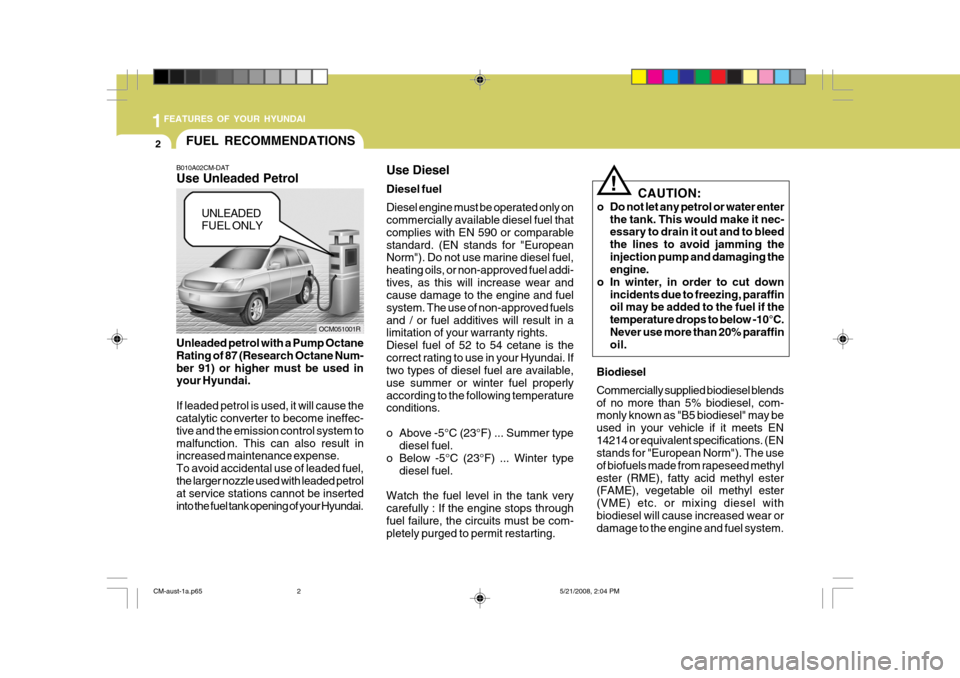
1FEATURES OF YOUR HYUNDAI
2
OCM051001R
Unleaded petrol with a Pump Octane Rating of 87 (Research Octane Num-ber 91) or higher must be used in your Hyundai. If leaded petrol is used, it will cause the catalytic converter to become ineffec- tive and the emission control system tomalfunction. This can also result in increased maintenance expense. To avoid accidental use of leaded fuel,the larger nozzle used with leaded petrol at service stations cannot be inserted into the fuel tank opening of your Hyundai.
B010A02CM-DAT Use Unleaded Petrol
FUEL RECOMMENDATIONS
UNLEADED FUEL ONLY
!
Use Diesel Diesel fuel Diesel engine must be operated only on commercially available diesel fuel that complies with EN 590 or comparablestandard. (EN stands for "European Norm"). Do not use marine diesel fuel, heating oils, or non-approved fuel addi-tives, as this will increase wear and cause damage to the engine and fuel system. The use of non-approved fuelsand / or fuel additives will result in a limitation of your warranty rights. Diesel fuel of 52 to 54 cetane is thecorrect rating to use in your Hyundai. If two types of diesel fuel are available, use summer or winter fuel properlyaccording to the following temperature conditions.
o Above -5°C (23°F) ... Summer type
diesel fuel.
o Below -5°C (23°F) ... Winter type diesel fuel.
Watch the fuel level in the tank very carefully : If the engine stops through fuel failure, the circuits must be com- pletely purged to permit restarting. CAUTION:
o Do not let any petrol or water enter the tank. This would make it nec- essary to drain it out and to bleed the lines to avoid jamming theinjection pump and damaging the engine.
o In winter, in order to cut down
incidents due to freezing, paraffinoil may be added to the fuel if the temperature drops to below -10°C.Never use more than 20% paraffin oil.
Biodiesel Commercially supplied biodiesel blends of no more than 5% biodiesel, com- monly known as "B5 biodiesel" may be used in your vehicle if it meets EN14214 or equivalent specifications. (EN stands for "European Norm"). The use of biofuels made from rapeseed methylester (RME), fatty acid methyl ester (FAME), vegetable oil methyl ester (VME) etc. or mixing diesel withbiodiesel will cause increased wear or damage to the engine and fuel system.
CM-aust-1a.p65 5/21/2008, 2:04 PM
2
Page 61 of 269
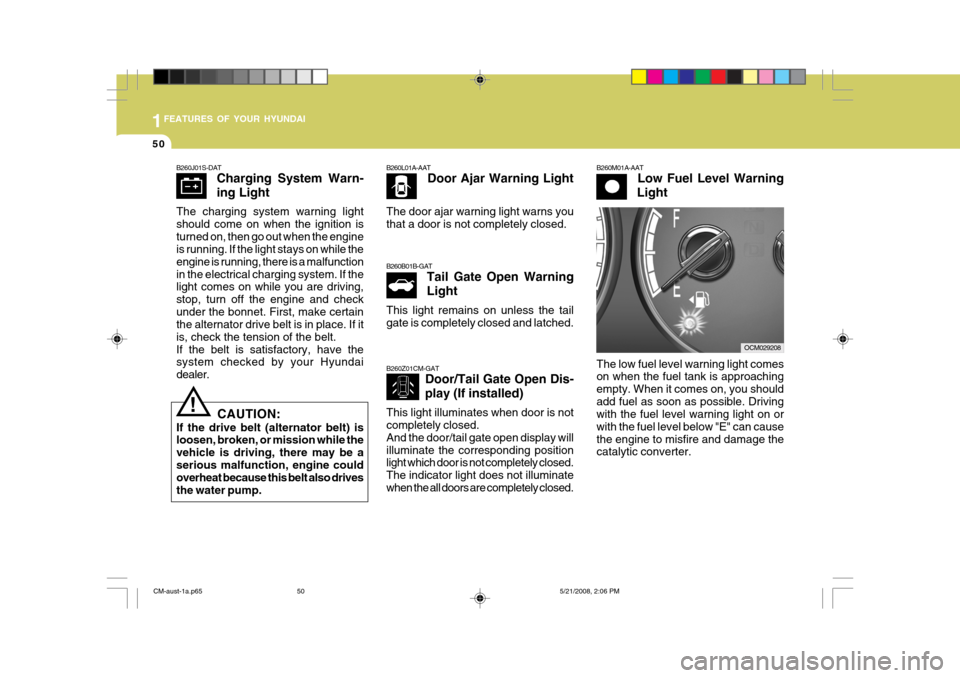
1FEATURES OF YOUR HYUNDAI
50
B260J01S-DAT
Charging System Warn- ing Light
The charging system warning light should come on when the ignition isturned on, then go out when the engine is running. If the light stays on while the engine is running, there is a malfunctionin the electrical charging system. If the light comes on while you are driving, stop, turn off the engine and checkunder the bonnet. First, make certain the alternator drive belt is in place. If it is, check the tension of the belt.If the belt is satisfactory, have the system checked by your Hyundai dealer. B260L01A-AAT
Door Ajar Warning Light
The door ajar warning light warns youthat a door is not completely closed. B260M01A-AAT
Low Fuel Level Warning
Light
B260B01B-GAT Tail Gate Open Warning Light
This light remains on unless the tail gate is completely closed and latched.
! CAUTION:
If the drive belt (alternator belt) is loosen, broken, or mission while the vehicle is driving, there may be aserious malfunction, engine could overheat because this belt also drives the water pump. B260Z01CM-GAT
Door/Tail Gate Open Dis- play (If installed)
This light illuminates when door is not completely closed. And the door/tail gate open display willilluminate the corresponding position light which door is not completely closed. The indicator light does not illuminatewhen the all doors are completely closed.
The low fuel level warning light comes on when the fuel tank is approaching empty. When it comes on, you shouldadd fuel as soon as possible. Driving with the fuel level warning light on or with the fuel level below "E" can causethe engine to misfire and damage the catalytic converter.
OCM029208
CM-aust-1a.p65 5/21/2008, 2:06 PM
50
Page 66 of 269
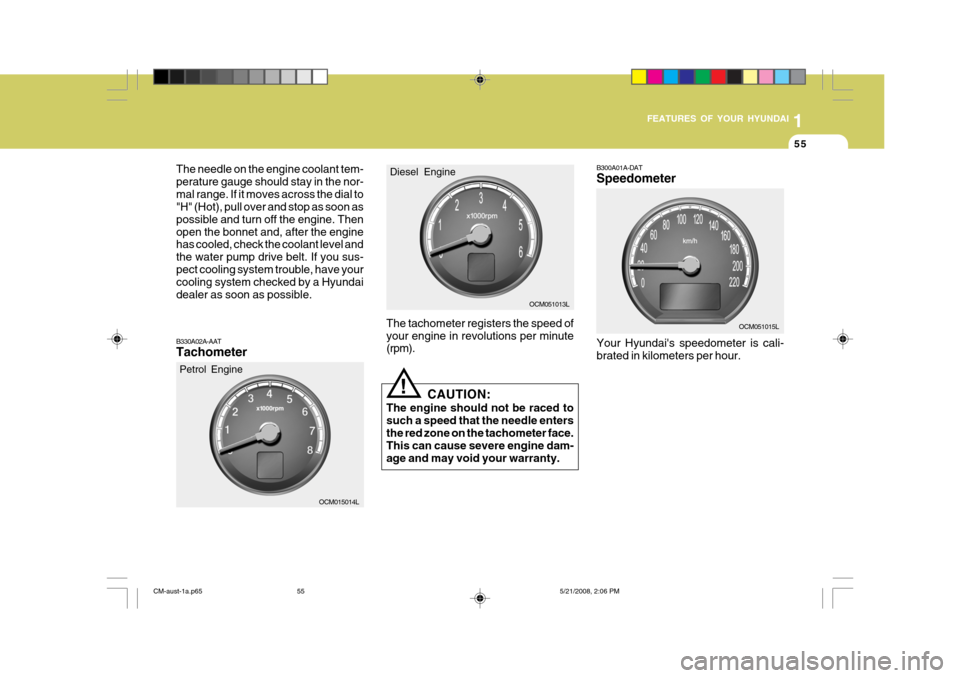
1
FEATURES OF YOUR HYUNDAI
55
The needle on the engine coolant tem- perature gauge should stay in the nor-mal range. If it moves across the dial to "H" (Hot), pull over and stop as soon as possible and turn off the engine. Thenopen the bonnet and, after the engine has cooled, check the coolant level and the water pump drive belt. If you sus-pect cooling system trouble, have your cooling system checked by a Hyundai dealer as soon as possible.
B330A02A-AAT Tachometer The tachometer registers the speed of your engine in revolutions per minute (rpm).
OCM015014L CAUTION:
The engine should not be raced to such a speed that the needle entersthe red zone on the tachometer face. This can cause severe engine dam- age and may void your warranty.
!
Petrol Engine
OCM051013L
Diesel Engine
OCM051015L
B300A01A-DAT Speedometer Your Hyundai's speedometer is cali- brated in kilometers per hour.
CM-aust-1a.p65
5/21/2008, 2:06 PM
55
Page 168 of 269
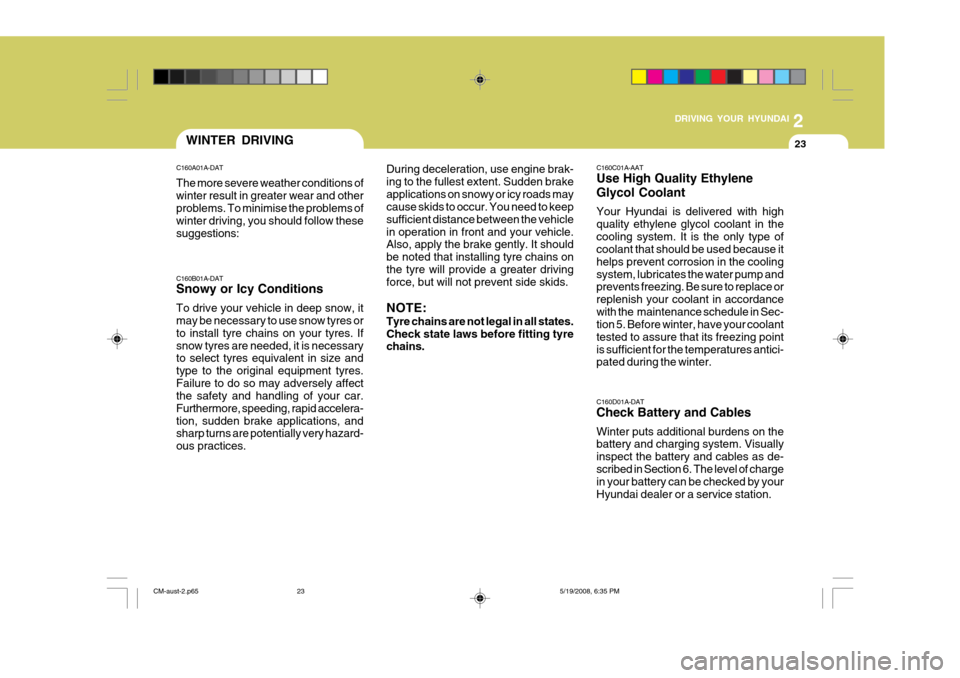
2
DRIVING YOUR HYUNDAI
23WINTER DRIVING
C160A01A-DAT The more severe weather conditions of winter result in greater wear and other problems. To minimise the problems of winter driving, you should follow thesesuggestions: C160C01A-AAT Use High Quality Ethylene Glycol Coolant Your Hyundai is delivered with high quality ethylene glycol coolant in thecooling system. It is the only type of coolant that should be used because it helps prevent corrosion in the coolingsystem, lubricates the water pump and prevents freezing. Be sure to replace or replenish your coolant in accordancewith the maintenance schedule in Sec- tion 5. Before winter, have your coolant tested to assure that its freezing pointis sufficient for the temperatures antici- pated during the winter.
C160B01A-DAT Snowy or Icy Conditions To drive your vehicle in deep snow, it may be necessary to use snow tyres or to install tyre chains on your tyres. If snow tyres are needed, it is necessary to select tyres equivalent in size and type to the original equipment tyres.Failure to do so may adversely affect the safety and handling of your car. Furthermore, speeding, rapid accelera-tion, sudden brake applications, and sharp turns are potentially very hazard- ous practices. During deceleration, use engine brak-ing to the fullest extent. Sudden brakeapplications on snowy or icy roads may cause skids to occur. You need to keep sufficient distance between the vehiclein operation in front and your vehicle. Also, apply the brake gently. It should be noted that installing tyre chains onthe tyre will provide a greater driving force, but will not prevent side skids. NOTE: Tyre chains are not legal in all states. Check state laws before fitting tyre chains.
C160D01A-DAT Check Battery and Cables Winter puts additional burdens on the battery and charging system. Visually inspect the battery and cables as de-scribed in Section 6. The level of charge in your battery can be checked by your Hyundai dealer or a service station.
CM-aust-2.p65 5/19/2008, 6:35 PM
23
Page 179 of 269
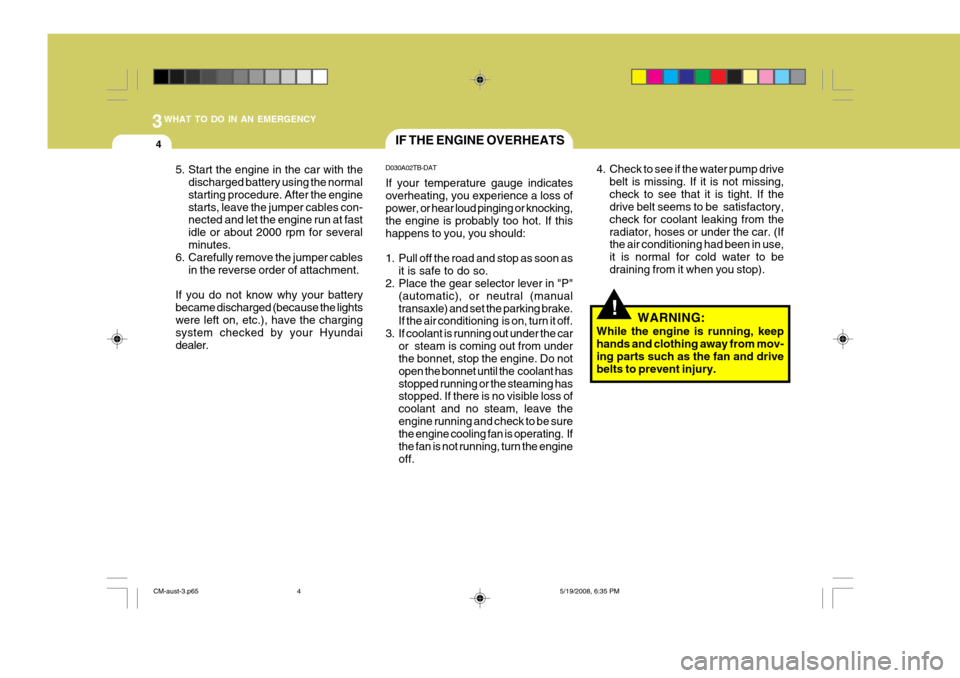
3WHAT TO DO IN AN EMERGENCY
4
!
IF THE ENGINE OVERHEATS
4. Check to see if the water pump drivebelt is missing. If it is not missing, check to see that it is tight. If the drive belt seems to be satisfactory, check for coolant leaking from theradiator, hoses or under the car. (If the air conditioning had been in use, it is normal for cold water to bedraining from it when you stop).
D030A02TB-DAT If your temperature gauge indicates overheating, you experience a loss of power, or hear loud pinging or knocking, the engine is probably too hot. If thishappens to you, you should:
1. Pull off the road and stop as soon as
it is safe to do so.
2. Place the gear selector lever in "P"
(automatic), or neutral (manual transaxle) and set the parking brake. If the air conditioning is on, turn it off.
3. If coolant is running out under the car or steam is coming out from underthe bonnet, stop the engine. Do not open the bonnet until the coolant hasstopped running or the steaming has stopped. If there is no visible loss of coolant and no steam, leave theengine running and check to be sure the engine cooling fan is operating. If the fan is not running, turn the engineoff. WARNING:
While the engine is running, keephands and clothing away from mov-ing parts such as the fan and drive belts to prevent injury.
5. Start the engine in the car with the
discharged battery using the normal starting procedure. After the enginestarts, leave the jumper cables con- nected and let the engine run at fast idle or about 2000 rpm for severalminutes.
6. Carefully remove the jumper cables
in the reverse order of attachment.
If you do not know why your batterybecame discharged (because the lightswere left on, etc.), have the charging system checked by your Hyundai dealer.
CM-aust-3.p65 5/19/2008, 6:35 PM
4
Page 180 of 269
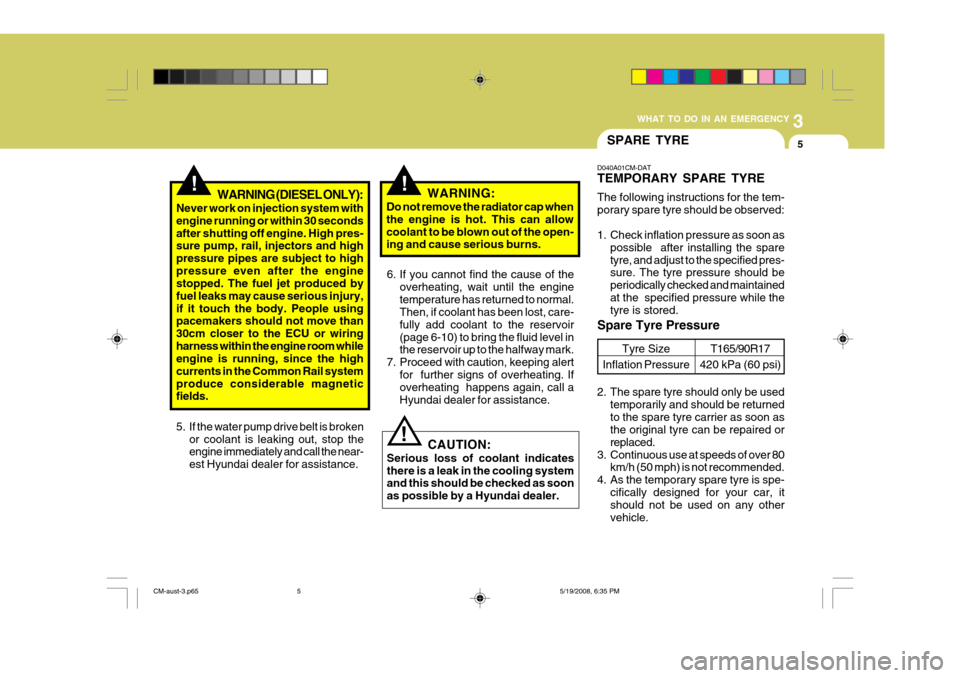
3
WHAT TO DO IN AN EMERGENCY
5
!
5. If the water pump drive belt is broken
or coolant is leaking out, stop the engine immediately and call the near- est Hyundai dealer for assistance. WARNING:
Do not remove the radiator cap whenthe engine is hot. This can allowcoolant to be blown out of the open- ing and cause serious burns.
!WARNING (DIESEL ONLY):
Never work on injection system with engine running or within 30 secondsafter shutting off engine. High pres- sure pump, rail, injectors and high pressure pipes are subject to highpressure even after the engine stopped. The fuel jet produced by fuel leaks may cause serious injury,if it touch the body. People using pacemakers should not move than 30cm closer to the ECU or wiringharness within the engine room while engine is running, since the high currents in the Common Rail systemproduce considerable magnetic fields. 6. If you cannot find the cause of the
overheating, wait until the engine temperature has returned to normal. Then, if coolant has been lost, care- fully add coolant to the reservoir(page 6-10) to bring the fluid level in the reservoir up to the halfway mark.
7. Proceed with caution, keeping alert for further signs of overheating. Ifoverheating happens again, call a Hyundai dealer for assistance.
CAUTION:
Serious loss of coolant indicatesthere is a leak in the cooling system and this should be checked as soon as possible by a Hyundai dealer.
!
SPARE TYRE
D040A01CM-DAT TEMPORARY SPARE TYRE The following instructions for the tem- porary spare tyre should be observed:
1. Check inflation pressure as soon as possible after installing the spare tyre, and adjust to the specified pres- sure. The tyre pressure should be periodically checked and maintainedat the specified pressure while the tyre is stored.
Spare Tyre Pressure
Tyre Size
Inflation PressureT165/90R17
420 kPa (60 psi)
2. The spare tyre should only be used temporarily and should be returned to the spare tyre carrier as soon as the original tyre can be repaired or replaced.
3. Continuous use at speeds of over 80 km/h (50 mph) is not recommended.
4. As the temporary spare tyre is spe-
cifically designed for your car, it should not be used on any other vehicle.
CM-aust-3.p65 5/19/2008, 6:35 PM
5
Page 202 of 269
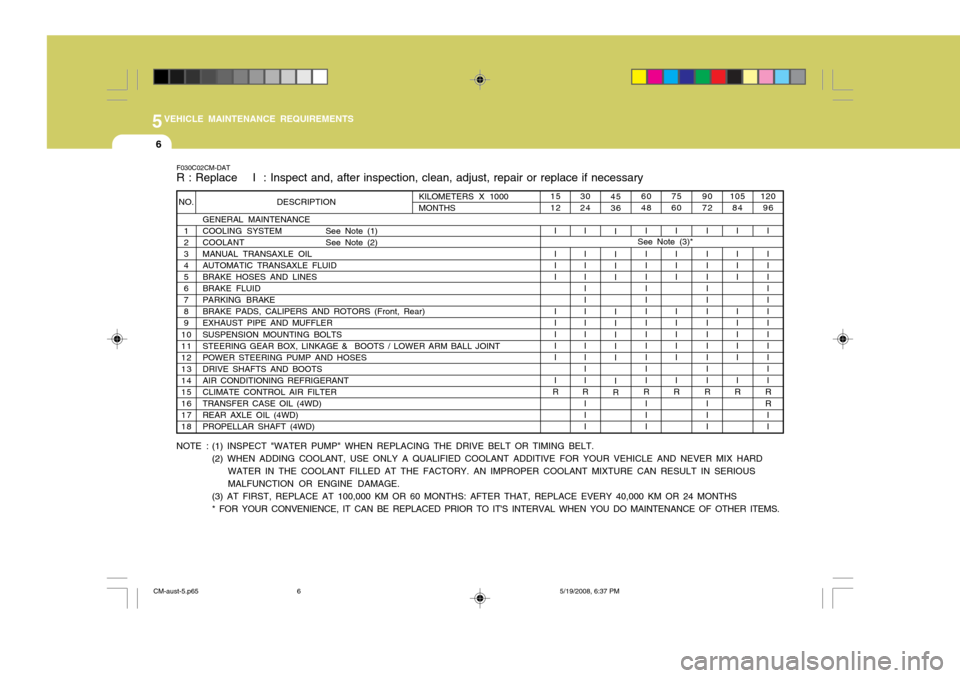
5VEHICLE MAINTENANCE REQUIREMENTS
6
F030C02CM-DAT R : Replace I : Inspect and, after inspection, clean, adjust, repair or replace if necessary
NOTE : (1) INSPECT "WATER PUMP" WHEN REPLACING THE DRIVE BELT OR TIMING BELT. (2) WHEN ADDING COOLANT, USE ONLY A QUALIFIED COOLANT ADDITIVE FOR YOUR VEHICLE AND NEVER MIX HARD
WATER IN THE COOLANT FILLED AT THE FACTORY. AN IMPROPER COOLANT MIXTURE CAN RESULT IN SERIOUS MALFUNCTION OR ENGINE DAMAGE.
(3) AT FIRST, REPLACE AT 100,000 KM OR 60 MONTHS: AFTER THAT, REPLACE EVERY 40,000 KM OR 24 MONTHS * FOR YOUR CONVENIENCE, IT CAN BE REPLACED PRIOR TO IT'S INTERVAL WHEN YOU DO MAINTENANCE OF OTHER ITEMS. 75 60
I I II I I III I
R 90 72
I I IIIII I IIIII
R
III
1512
I I II I I III I
R See Note (3)*
DESCRIPTION
GENERAL MAINTENANCE
COOLING SYSTEM See Note (1)COOLANT See Note (2)
MANUAL TRANSAXLE OIL AUTOMATIC TRANSAXLE FLUID BRAKE HOSES AND LINESBRAKE FLUIDPARKING BRAKEBRAKE PADS, CALIPERS AND ROTORS (Front, Rear)EXHAUST PIPE AND MUFFLER SUSPENSION MOUNTING BOLTS STEERING GEAR BOX, LINKAGE & BOOTS / LOWER ARM BALL JOINTPOWER STEERING PUMP AND HOSESDRIVE SHAFTS AND BOOTSAIR CONDITIONING REFRIGERANTCLIMATE CONTROL AIR FILTERTRANSFER CASE OIL (4WD) REAR AXLE OIL (4WD) PROPELLAR SHAFT (4WD)
NO.
123 4 56789
10111213141516 17 18
30 24
I I IIIII I IIIII
R
III 4536
I I II I IIII I
R 60 48
I I IIIII I IIIII
R
III 105
84
I I II I I III I
R 120
96
I I IIIII I IIIII
R R I IKILOMETERS X 1000 MONTHS
CM-aust-5.p65 5/19/2008, 6:37 PM
6